In this first post, out of two, we will introduce the frameworks to combine to get an innovation process end-to-end. We will review Design Thinking, Lean Startup, Agile, Outcome Driven Innovation, Impact Mapping and Story Mapping.
- All frameworks have their focus, innovation process included
- Introduction of the frameworks to combine for an innovation process
- What's next? Learn more about how to combine Design Thinking, Lean Startup and Agile as a single end-to-end innovation process
- Do you want to learn more about these innovation frameworks? Here are some valuable references
All frameworks have their focus, innovation process included
Whatever the framework, it has its focus area. Issue is when you need to combine several frameworks is that they all have their own focus area. Firstly, they may have overlaps or have gaps in the full scope to cover. Secondly, they may be more or less relevant than the others for a given area.
Innovation cycle is a good example. It goes from the generation of an idea of business, passing by the design of the underlying business model. Then it continues with the design, the build and the delivery of the related product or service.
So, we have selected here several frameworks that business and IT practitioners commonly try to combine to have an end-to-end innovation process.
Here is the list of frameworks that we will shortly introduce:
- Design Thinking (also related to Google Venture Design Sprint)
- Lean Startup
- Agile (we will refer here to Scrum framework)
We will also leverage for this exercise and introduce:
- The Impact mapping
- The story mapping
- The Outcome Driven Innovation that uses the notions of:
- Job-to-be done, the problem the customer wants to achieve,
- Desired outcome, the expected outcome to satisfy the customer need.
Here is an illustration of how these frameworks cover the full innovation process. From an idea of business to the delivery of the product or service to the market.
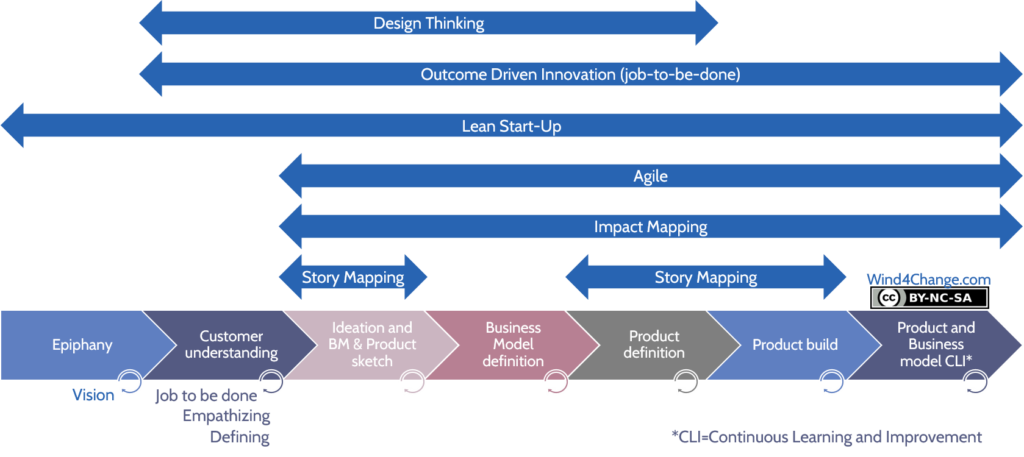
Introduction of the frameworks to combine for an innovation process
Design thinking
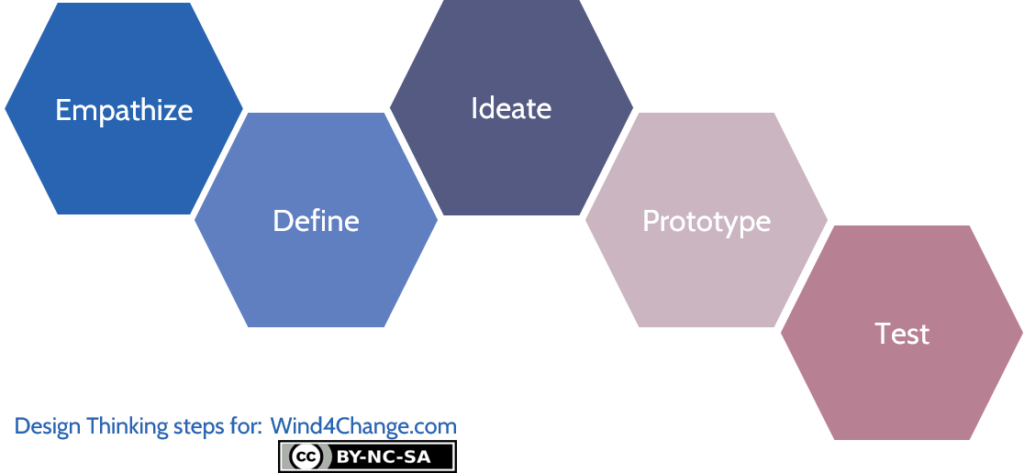
Obviously, Design Thinking is nothing new. Indeed, Rolf Faste, Design Professor in Stanford, created Design Thinking in the 90s. In addition, he elaborated on the works of Robert McKim dating from the 70s.
Design Thinking has 5 steps, at least the last 2 steps are to iterate:
- Empathize: learn about the customer for whom you are designing
- Define: characterize the problem to be solved
- Ideate: generate ideas then select them to sketch a solution or a set of solutions
- Prototype: build an experiment to test your solution
- Test: confirm or deny your potential solution with the prototype
Surely, the scope of Design Thinking is essentially from customer understanding to product development.
Lean Startup
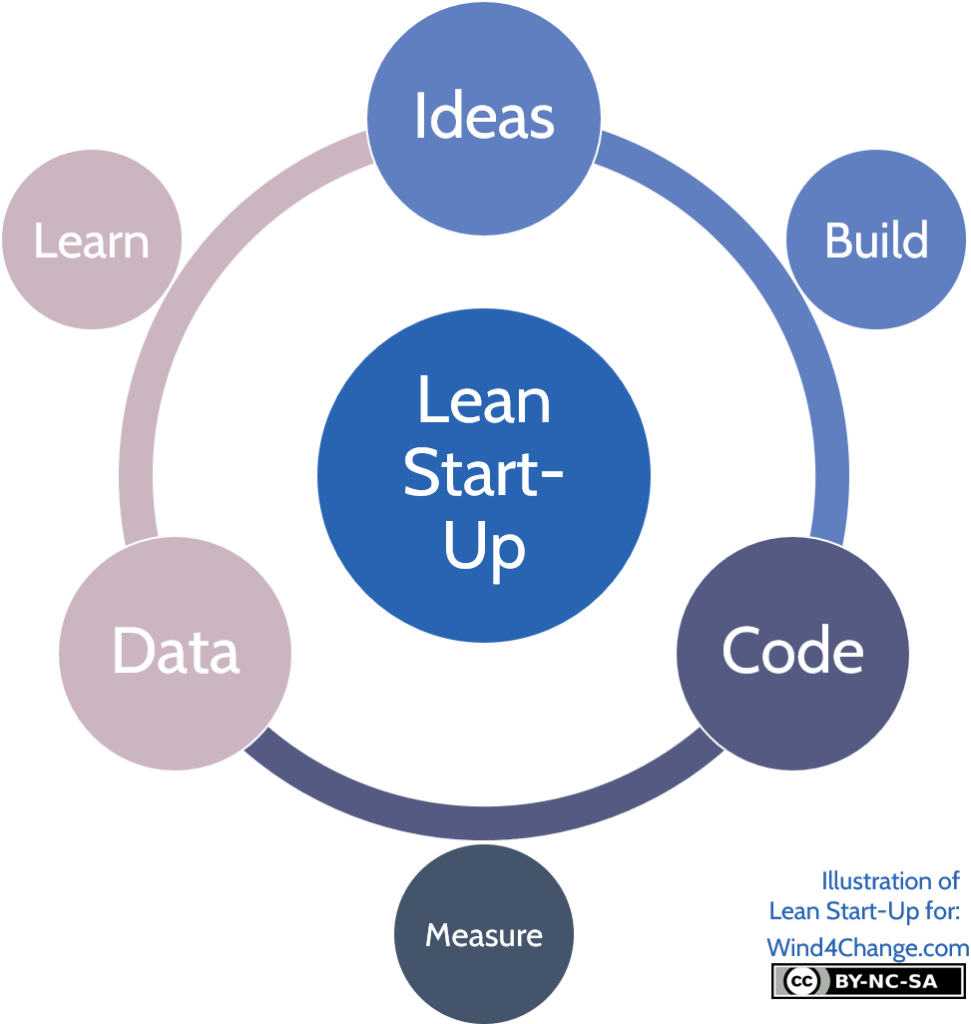
The lean startup approach was first proposed in 2008 by Eric Ries. He used his personal experiences adapting lean management and customer development principles to high-tech startup companies.
Like lean manufacturing and lean software development, the lean startup purpose is to eliminate wasteful practices and increase those generating value. But this during the earliest phases of a company. Without a doubt, this increases the chance for the company to succeed. Indeed, it prevents the need for a large amount of outside funding and to elaborate a complex business plans or a perfect product.
As a matter of fact, Lean startup enables shortening and lowering costs of product development cycles. Furthermore, it makes it possible to rapidly and cheaply discover if a proposed business model is viable. Lean Start up achieves this by conducting business-hypothesis-driven experimentation then iterative product releases to validate assumptions and to increase learning. During this iterative approach the business model and/or the product adapt and may even drastically change in order become viable. Actually, this is what Lean Start up is calls a pivot.
Lean Startup covers the full scope of the innovation process. From an idea of business to the business model with the related product or service. But the acquisition of initial knowledge of the customer is not much developed. Instead, the approach uses quick iterations to validate assumptions on the field.
Agile

Agile software development frameworks share the same characteristics. At first, Teams are self-organized and collaborate with their customers to adapt requirements and solutions while learning from the field. In addition, it is based on adaptive and iterative planning, evolutionary development, early delivery, and continual improvement. In truth, this enables rapid and flexible response to change and innovation.
Agile covers by nature the full scope of the innovation process. Nevertheless the main frameworks like Scrum or Kanban do not explain much about the framing phase with overall customer understanding and first definition of the product. Yet some tools in the Agile community support ideation and product sketch steps like Impact Mapping and Story Mapping. At last, Agile does not cover the Business Model.
For more information, review my other posts on introduction to:
Outcome Driven Innovation
Outcome-Driven Innovation (ODI) is a strategy and innovation process developed by Anthony W. Ulwick in 2005. It is built around the concept that people buy products and services to get jobs done. Indeed, as people complete these jobs, they get measurable outcomes filling their needs.
Really, this is an important shift of approach. Instead of studying customers to guess their needs, ask them. But do not ask about the expected solution: collect the problem they want to solve, the job to be done.
This approach covers the full scope of the innovation process. It includes the strategy to market and grow the product and even the product portfolio management. But Outcome Driven Innovation does not cover the Business Model.
Impact Mapping
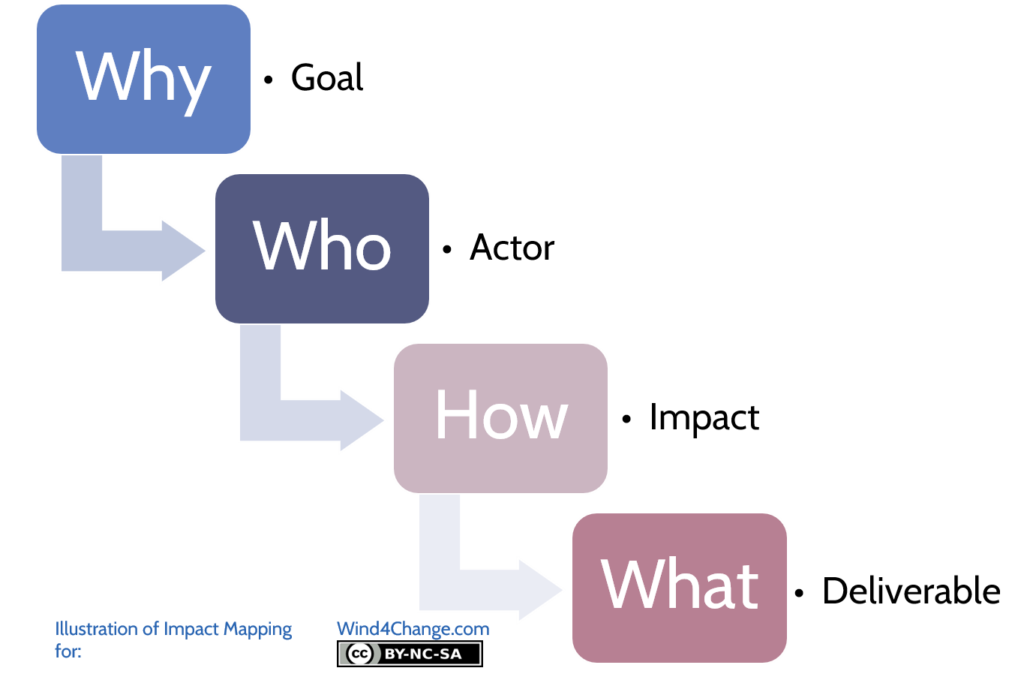
Gojko Adzic built impact mapping combining several other approaches. They are: InUse effect mapping method, impact maps for training organizations, the feature injection ideas and the measurability and iterative delivery ideas.
An impact map is a visualization of a product scope and underlying assumptions. As a result, it enables the connection between the objectives, the levers to reach them and the deliverables or actions. It supports also a common vision between the business and technical contributors. Indeed, it is typically created collaboratively by these 2 populations.
This mind map structures over 4 levels:
- Why, the goal
- Who, the people targeted
- How, the impact expected
- What, the deliverables or actions to be conducted
This tool covers the full scope of the innovation process and brings structure at all steps. Indeed, it consolidates the information about the product.
Story Mapping
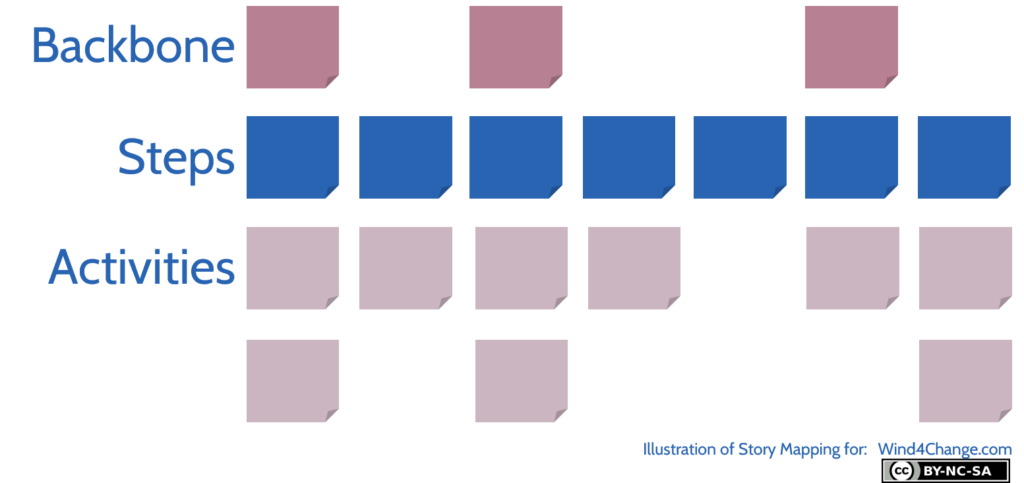
Jeff Patton invented Story Mapping. A story map is a simple but powerful way to arrange stories as a customer journey. It is structured in business areas, features and at last user stories.
This tools brings structure to the backlog in addition to the Impact Map. It does not embed impact but it supports consistency and glue thanks to its customer journey approach. It is also quite useful for the business to express its vision. At last, it enables splitting features in iterations. Surely, both approaches complement nicely.
What’s next? Learn more about how to combine Design Thinking, Lean Startup and Agile as a single end-to-end innovation process
To learn how to combine all these innovation frameworks, check my other post. But you have to request access to this page.
In addition, learn more about innovation with all my posts about Digital and the disruptive technologies.
Do you want to learn more about these innovation frameworks? Here are some valuable references
Design Thinking:
- General information
- D.School Design Thinking Bootleg
- Book: The Design Thinking Playbook
- Book: Designing for Growth
Lean startup:
- General information
- Learning more about Lean Startup
- Book: The Lean Startup
- The website of the author, Eric Ries: LeanStartUp
- Book: Running Lean
- The website of the author, Ash Maurya: LeanStack
Outcome driven innovation:
- General information
- Book: Jobs to be Done: Theory to Practice
- The website of the author, Anthony W. Ulwick
Impact Mapping
- General information
- A good post about Impact Mapping
- Book: Impact Mapping
- The website of the author, Gojko Adzic
Story Mapping
- Quick Reference guide, from the website of the author, Jeff Patton
- Article describing the approach, from the website of the author
- Book: User Story Mapping
